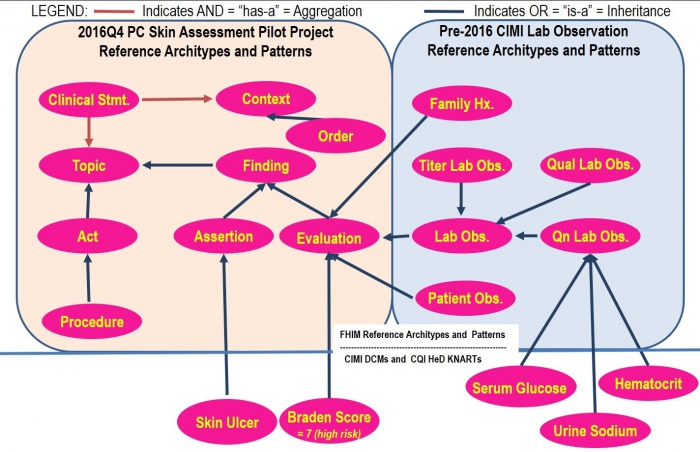CIMI Architecture: Clinical View
HL7 Patient Care Workgroup’s Wound Care Pilot Project Status
Figure: Clinical Perspective of CLIM Reference Architypes, Patterns, DCMs And HeD KNARTs Based on SNOMED Observable Model
Historically. CIMI focused on lab-result OBSERVATIONs; where, the Patient Care WG’s CIMI validation wound/Skin Assessment pilot study added clinical-statement FINDINGs, ASSERTIONs and EVALUATIONs (AKA OBSERVATIONs or RESULTs) as shown in Figure 3. The ‘2016Q4 EVALUATION_RESULT = the pre-2016 OBSERVATION in “Lab OBSERVATION”. Briefly, models based on CIMI, FHIM, QI Core, and US Core specifications, and using SOLOR terminologies require ambiguities to be resolved / harmonized. Galen, Claude, Richard, Susan and Jay are working on the harmonization represented in Figure 2 . The HL7 Patient Care Workgroup Wound Assessment Pilot Project is providing the reference use-case and information model for this pilot study. Claude and Galen have defined candidate clinical FINDING, ASSERTION and EVALUATION_RESULT Reference Architypes and Patterns, as shown in Figure 3 and the teams are working through concept inconsistencies. As an example, another inconsistency is the “SIGNATURE” concept which in FHIM is simply ATTRIBUTION (set of persons signing or cosigning a clinical statement), while in CIMI “SIGNATURE” is an ACT (EVENT) with full SNOMED CONTEXT (who, what, when, where, how, etc.); where, FHIM is migrating to the CIMI approach. Susan argues that Family Hx. and Patient Obx. Are ASSERTIONS; but, Stan points out that ASSERTION and EVALUATION_RESULT are structures, without implying semantics, and that any ASSERTION can be represented as a EVALUATION_RESULT (e.g., LOINC question and SNOMED reply pair).
Lively January HL7 workgroup meeting discussions on Reference Architypes, Patterns, DCMs and KNARTs, and FHIR implementation models and tools, resulted in the Figure's FINDING (AKA OBSERVABLE) having both ASSERTION and EVALUATION_RESULT patterns; where, discussions are summarized in the Attachment. Note that both patterns have semantically equivalent structural patterns and are not arbitrary classifications (e.g., objective vs. subjective); where, the EVALUATION_RESULT pattern is generally a “LOINC-question and SNOMED-answer pair” (AKA FINDING, OBSERVATION); and, the ASSERTION pattern (AKA CONDITION, PROBLEM, DIAGNOSIS) implies the definition of a SNOMED concept (e.g., The patient has diabetes or skin ulcers; where, diabetes or skin ulcer are defined by one or more clinical evaluations).
